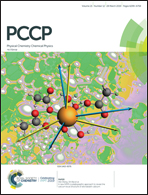The vibrational CD spectra of propylene oxide in liquid xenon: a proof-of-principle CryoVCD study that challenges theory†
Abstract
Propylene oxide (PO) is one of the smallest chiral molecules and thus the ideal candidate to benchmark both new experimental and theoretical approaches. Previous studies on the fingerprint region of the IR and VCD spectra of PO under matrix-isolation conditions revealed a good performance of theoretical approaches to reproduce anharmonic frequencies and intensities. For certain bands which were found to be involved in Fermi resonances, theory did not agree with the experimental observations. Herein we present the IR and VCD spectra of PO recorded in liquefied xenon, an experimental environment which combines the advantages of solution phase and matrix environment. This unique environment allows us to record well-resolved VCD signatures of many combination modes. We show that the VCD signatures of the Fermi resonant modes previously reported for MI-VCD conditions are likely to arise due to matrix effects. Therefore, we compare the experimental results obtained in liquid xenon with state-of-the-art anharmonic spectra calculations in order to shed more light on the assignments of the IR and VCD spectral signatures of PO.

- This article is part of the themed collection: 2019 PCCP HOT Articles


 Please wait while we load your content...
Please wait while we load your content...